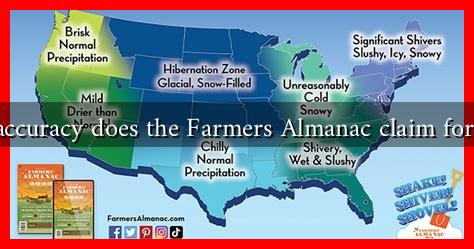-
Table of Contents
What Historical Accuracy Does the Farmers’ Almanac Claim for Winter Forecasts?
The Farmers’ Almanac, a publication that has been around since 1818, is renowned for its long-range weather predictions, particularly for winter forecasts. With a reputation built over centuries, many people turn to the Almanac for guidance on what to expect during the colder months. But how accurate are these forecasts? This article delves into the historical accuracy of the Farmers’ Almanac’s winter predictions, examining its methodology, past performance, and the science behind its forecasts.
The Methodology Behind the Predictions
The Farmers’ Almanac employs a unique formula for its weather predictions, which is based on a combination of solar cycles, climatology, and meteorology. The Almanac’s forecasting process includes:
- Solar Activity: The Almanac considers the sun’s cycles, including sunspots and solar flares, which can influence weather patterns.
- Climatology: Historical weather data is analyzed to identify patterns and trends that may recur in future seasons.
- Mathematical Algorithms: The Almanac uses proprietary algorithms to synthesize data and generate forecasts.
This blend of traditional knowledge and modern science aims to provide a comprehensive outlook on upcoming weather conditions, particularly for winter, when accurate predictions can significantly impact agriculture, travel, and daily life.
Historical Accuracy: A Closer Look
When evaluating the accuracy of the Farmers’ Almanac’s winter forecasts, it is essential to consider both anecdotal evidence and statistical data. Over the years, the Almanac has claimed an accuracy rate of approximately 80% for its long-range forecasts.
. However, this figure is often met with skepticism from meteorologists and weather experts.
For instance, a study conducted by the National Oceanic and Atmospheric Administration (NOAA) found that long-range forecasts, including those from the Farmers’ Almanac, often struggle to maintain high accuracy rates. The study highlighted that while the Almanac may provide a general sense of seasonal trends, specific predictions—such as exact temperatures or precipitation levels—are less reliable.
Case Studies: Notable Winter Forecasts
To better understand the Almanac’s performance, we can look at specific winter forecasts from recent years:
- Winter 2020-2021: The Farmers’ Almanac predicted a “polar coaster” winter with above-average snowfall in the Midwest and Northeast. Many regions did experience significant snowfall, aligning with the Almanac’s forecast.
- Winter 2019-2020: The Almanac forecasted a mild winter for much of the United States. However, many areas experienced colder-than-expected temperatures, leading to criticism of the forecast’s accuracy.
- Winter 2018-2019: The Almanac predicted a colder-than-average winter for the Midwest, which was largely accurate, as many states experienced severe cold snaps and heavy snowfall.
These case studies illustrate that while the Farmers’ Almanac can sometimes hit the mark, there are also instances where its predictions fall short. This inconsistency raises questions about the reliability of its long-range forecasts.
Comparing with Modern Meteorology
Modern meteorology relies heavily on advanced technology, including satellite imagery, computer modeling, and real-time data analysis. These tools allow meteorologists to make more precise short-term forecasts, often with greater accuracy than long-range predictions. For example, the National Weather Service (NWS) uses sophisticated models that can predict weather patterns up to 14 days in advance with a high degree of accuracy.
In contrast, the Farmers’ Almanac’s long-range forecasts are more generalized and less specific, which can lead to a perception of higher accuracy. However, as weather patterns become increasingly unpredictable due to climate change, even modern meteorological methods face challenges in accuracy.
Conclusion: The Takeaway
The Farmers’ Almanac has a long-standing tradition of providing winter forecasts that many people rely on. While it claims an accuracy rate of around 80%, the reality is more nuanced. Its predictions can sometimes align with actual weather patterns, but there are also notable discrepancies. As technology advances, the gap between traditional forecasting methods and modern meteorology continues to widen.
Ultimately, while the Farmers’ Almanac can offer a general sense of what to expect during winter, it is essential for individuals to consult multiple sources, including local meteorological services, for the most accurate and timely weather information. For more insights into weather forecasting, you can visit the NOAA website.





